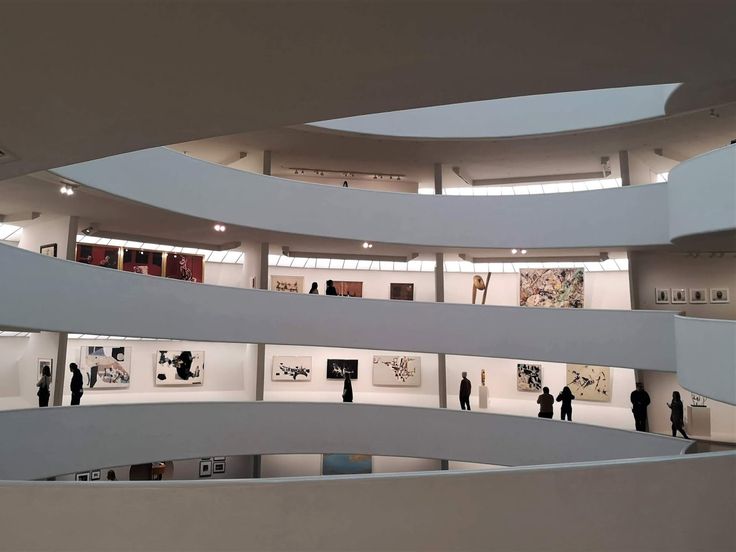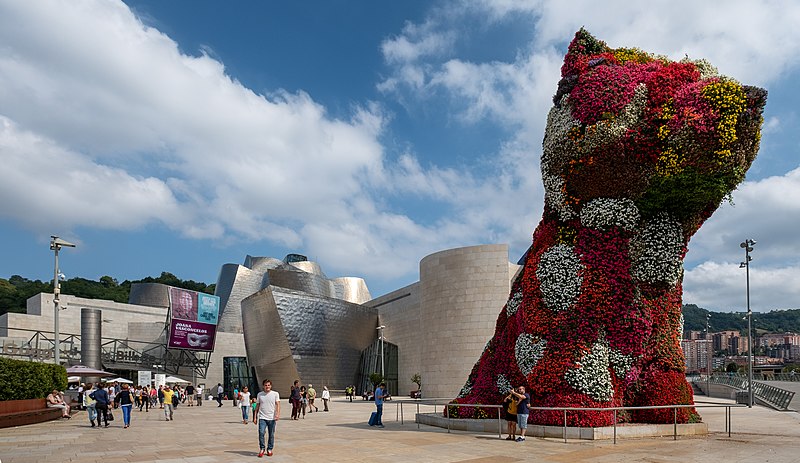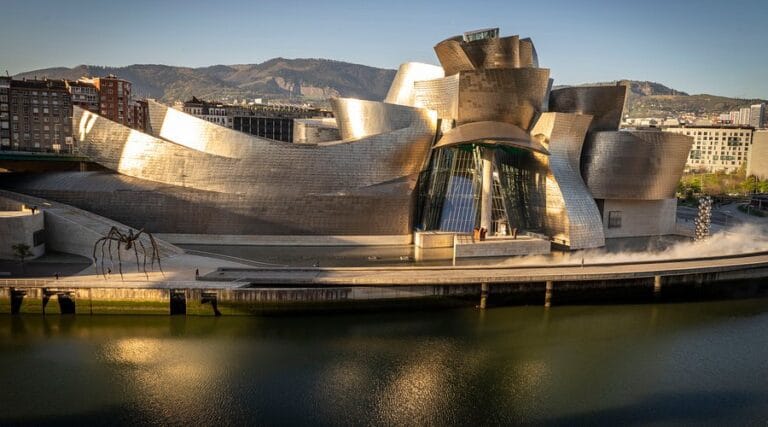Table of Contents
Toggle✨ Introduction
When you think of modern art in Spain, one name immediately stands out — the Guggenheim Museum Bilbao.
Rising proudly along the Nervión River, this extraordinary building reshaped the identity of Bilbao and redefined how the world perceives contemporary art and architecture.
Before the museum opened in 1997, Bilbao was an industrial port city struggling with pollution and economic decline. Yet, in less than a decade, it became a global symbol of cultural renaissance, attracting millions of visitors and inspiring what is now known as “The Bilbao Effect.”
Visiting the Guggenheim is not just about admiring paintings or sculptures; it’s about experiencing art as emotion, architecture as movement, and culture as transformation. Whether you’re an art lover, architecture enthusiast, or traveler in search of inspiration, the Guggenheim Bilbao offers a journey that stays with you long after you leave.
🏗️ A Revolution in Architecture
The Guggenheim Museum Bilbao was designed by Frank Gehry, one of the world’s most visionary architects.
Its bold, curving titanium panels, glass walls, and limestone blocks defy the rigid geometry of traditional museums. The building feels alive — light changes its color throughout the day, and reflections from the river create a constant dialogue between art and nature.
Gehry described his vision as “a ship in the harbor,” symbolizing Bilbao’s maritime heritage. The museum covers 24,000 square meters, with nearly half dedicated to exhibition space — an immense canvas for creativity.
The building’s construction also represented a technological milestone: it was one of the first large-scale projects designed entirely using computer-aided design software (CATIA), allowing for its organic, flowing shapes to become reality.
🔗 Learn more about the museum’s design at the Official Guggenheim Museum Bilbao Architecture Page
🖼️ Inside the Guggenheim: A Journey Through Modern Art

Once inside, the museum offers a labyrinth of galleries connected by curving walkways and suspended bridges. The space itself feels like part of the exhibition.
The permanent collection celebrates some of the most influential artists of the 20th and 21st centuries:
Jeff Koons – Puppy, a monumental 12-meter floral sculpture guarding the museum entrance.
Richard Serra – The Matter of Time, a vast installation of steel spirals inviting visitors to walk inside the artwork.
Mark Rothko, Anselm Kiefer, and Yves Klein – each represented through powerful, large-scale works that push artistic boundaries.
In addition to its permanent exhibitions, the Guggenheim hosts temporary exhibitions from leading modern and contemporary artists. These change several times a year, ensuring every visit brings something new — from digital installations to immersive experiences blending sound, video, and sculpture.
🔗 Check current exhibitions at the Guggenheim Bilbao Exhibitions Page
🌆 Bilbao: From Industry to Innovation
Before the Guggenheim’s arrival, Bilbao faced economic stagnation and urban decay. The decision to build the museum marked a bold cultural gamble — and it paid off spectacularly.
The museum sparked what economists and urban planners now call “The Bilbao Effect”: a single world-class cultural institution that revives an entire city.
After 1997, Bilbao saw:
A 40% increase in tourism within the first year
A boom in restaurants, hotels, and public infrastructure
The creation of thousands of jobs and a thriving creative economy
Today, the museum is a cornerstone of Bilbao’s new identity — a dynamic city where tradition meets innovation, Basque culture blends with global art, and creativity thrives at every corner.
🔗 Learn more about Bilbao tourism at the Bilbao Tourism Official Site
🧭 What to See Around the Guggenheim

Your visit to the Guggenheim can easily turn into a full-day exploration. Nearby attractions include:
The Nervión River Promenade – perfect for scenic walks and photography.
Zubizuri Bridge, designed by Santiago Calatrava — a white pedestrian bridge linking the old and new Bilbao.
Casco Viejo (Old Town) – narrow medieval streets filled with shops, pintxo bars, and local markets.
The Fine Arts Museum of Bilbao, one of Spain’s oldest art museums, located just a short walk away.
Each site reflects Bilbao’s evolution — a city that embraces both its industrial roots and its artistic future.
🕒 Practical Visitor Information
📍 Location: Abandoibarra Etorb., 2, 48009 Bilbao, Spain
🕐 Opening Hours: Tuesday–Sunday, 10:00 AM – 8:00 PM (closed Mondays)
🎟️ Tickets: €16 adults | €9 students | Free for children under 12
🚇 How to Get There:
Metro: Moyua or Abando stations
Tram: Guggenheim stop
On foot: a 15-minute walk from the city center
💡 Travel Tips from Spanaly
Visit early in the morning or late afternoon to enjoy the museum in natural light.
Don’t miss “Puppy”, the floral guardian at the entrance — it changes colors with the seasons.
Photography is allowed in most areas, but be respectful of signage.
After your visit, enjoy Basque pintxos and a glass of txakoli wine at a nearby riverside café.
Combine your Guggenheim visit with a walk to Casco Viejo for the perfect blend of modern and traditional Bilbao.
💬 Conclusion
The Guggenheim Museum Bilbao is far more than an art gallery — it’s a living symbol of transformation, creativity, and renewal.
It tells the story of how art can change not only a city but also the way we view the world. From its titanium skin to its vibrant collection, the Guggenheim embodies the spirit of innovation and imagination that defines modern Spain.
If Spain is a country of history and culture, then Bilbao’s Guggenheim is its heartbeat of modernity — a must-visit destination for every traveler seeking inspiration.



[…] Guggenheim Museum: A Masterpiece of Modern Art Prado Museum: Spain’s Artistic Treasure […]